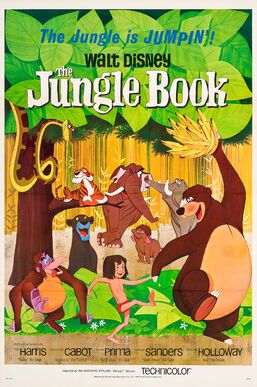It’s
fair to say Walt Disney provided me with a great deal of entertainment while
growing up. His colourful characters were in my storybooks, Saturday morning
cartoons, and in some of the first movies I saw as a child. “The Jungle Book,”
produced by Disney and directed by Wolfgang Reithermann, is filled with talking
animals, hand-drawn animation, and song and dance numbers. That’s all you
needed back in 1967, when the movie was made. There is no 3D, no big movie
stars providing the voices, and no pop-culture references.
This
is one of those movies that bring me back to a simpler time, when I couldn’t go
to bed past 10:00pm and when grandma’s apartment was the best place in the
world. That’s probably where I first saw this movie. Either that, or someone
read me the illustrated book based on the movie. You know the kind. There’s a
whole catalogue of short books filled with what are basically stills from
Disney movies with about five sentences on the right page to add narration. I
might also have had an audio version on an old cassette tape. I can’t be too
sure since it’s been at least 22 years. Either way, it did the job.
Based
on the 1894 novel by British author Rudyard Kipling, “The Jungle Book” tells
the story of Mowgli (Bruce Reithermann), a young boy raised by wolves in the
Indian jungle. When the wolves learn Shere Khan, a man-eating tiger, has
returned to the jungle, they decide he must return to his people. Bagheera
(Sebastian Cabot), a black panther who found Mowgli when he was a baby,
volunteers for the quest.
Before
making it to the village, they will run into a menagerie of animals, some
friends some foe. It is the jungle after all. Among the foes there is Kaa
(Sterling Holloway) a python who would love to have Mowgli for dinner; King
Louie (Louie Prima) an ape who kidnaps Mowgli to find out how to make fire; and
always lurking in the trees is the merciless Shere Khan (George Sanders).
Among
the friends you have the elephant patrol, led by colonel Hathi (J. Pat
O’Malley), who rules over his pack like a drill sergeant. Then there are four
vultures perched on a dead tree who are stuck in a perpetual cycle of boredom.
Their entire conversations revolve around the questions “What are we gonna do?”
and “What do you wanna do?” These guys desperately need some action.
The
most entertaining character is Baloo (Phil Harris), a bear whose carefree
lifestyle clashes with Bagheera’s seriousness. If Bagheera is the responsible
adult, Baloo is the teenager who never grew up. Why take Mowgli to the humans
when they could just hang out in the jungle, sleep in the shade, and eat? If
they were to do this movie now, they would probably have Jeff Bridges do the
voice, just to evoke the idea of The Dude from “The Big Lebowski” for the
grown-ups.
At a
brisk 78-minute running time, this is an effective movie for young children. It
should work even for today’s kids even if the movie was made back in the 1960s.
The animation still holds up, the musical numbers are entertaining, and the
fight scenes aren’t too scary. The fight between Baloo and Shere Khan towards
the end might be a bit unnerving, but if kids can survive Bambi’s mom getting
shot, they can survive this.
I
enjoyed this movie as a child, but in later years I enjoyed two other very
different adaptations of “The Jungle Book” which seriously deviated from the
Kipling novel.
First
there was there was the cartoon series “TaleSpin” which re-imagined Baloo as a
bush pilot in the fictional city of Cape Suzette. In this show King Louie is
the owner of a bar on his own private island and Shere Khan is a business
tycoon.
Second
was the 1994 live-action remake, directed by Stephen Sommers (“The Mummy”). In
this version, the animals actually kill a lot of people. Characters get buried
alive, drown in quicksand, get mauled by Shere Khan, and get their throats
ripped by Kaa the snake. Oddly enough, Walt Disney Pictures also distributed
this version.
So to
sum up, if you are an adult and you want to see a mash-up of Indiana Jones and
the “The Jungle Book” watch the live-action version. But if you have young
children, let them watch the 1967 version and wait until they are at least 12
before showing them the version where a man is chased by hungry tiger in the
jungle. (The tiger catches him.)

Comments
Post a Comment